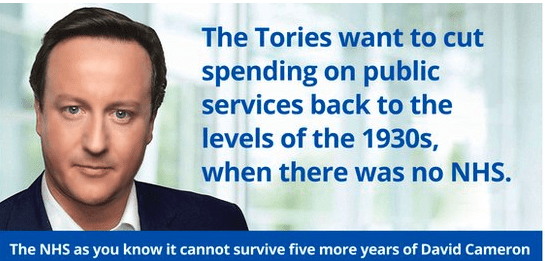Another day, another poster – and this time, it’s Labour stretching the truth. The above is the same trick as George Osborne was playing with the deficit. The reader is invited to believe that the Tories would cut state spending back to 1930s levels ‘when there was no NHS’ – or much of a welfare state at all, come to think of it. In truth, George Osborne has (unwisely, in my view) pledged to increase NHS spending if re-elected and overall state spending will be at least five times higher than in the 1930s. So how can Labour get away with this – and how did this deception enter the public realm?
This ‘1930s’ line was the biggest single vulnerability of George Osborne’s statement last month. He should have spotted that this was the obvious attack line, and he should have closed it down before Labour used it as a stick to beat him with. Today’s poster is the first thwack of that stick.
The Chancellor wanted to draw a dividing line between Tories and Labour on the deficit, so he wanted to claim that he would run a significant budget surplus (ie, a negative deficit) by 2020. Here’s his new, extended deficit programme — notice the large, and unexplained, negative value at the end:

How did he plan to arrive at the £23 billion surplus? He wouldn’t say. All he said was that, after pretty slow cuts in this parliament, he’d make sharper cuts in the next one. As a result, state spending would end up at 35 per cent of GDP, back to levels seen at around year three of the Blair government — or the 1930s, depending on your point of view. Here is the graph:

So given that he’s protecting health, the single most expensive government department, how would he find these extra cuts? The lack of an answer annoyed the Office for Budget Responsibility. Robert Chote, who used to run the IFS and now runs the OBR, has a weakness for references to history rather than international comparisons. So on the day of Osborne’s Autumn Statement, the OBR had this to say:
‘The Government’s TME assumptions imply that spending will fall considerably further as a share of GDP, to 35.2 per cent of GDP in 2019-20. That would probably be the lowest in around 80 years.’
The lowest in 80 years! This is 2015, minus 80 that makes…. 1935! Even Labour’s attack department, which is bafflingly slow on the uptake, could work that one out.
And, to be honest, George Osborne should have as well. My hunch is that he was so keen to present the budget surplus figure that he didn’t quite work out that he had opened himself up to an attack. The OBB ought not to have included that rather hyperbolic 80 year line in an official document – from his time at the IFS Chote knows very well how such sentences can make headlines. Or, in this instance, Labour Party attack posters.
As the above chart shows, even as a share of GDP, state spending would be going only marginally lower than under Gordon Brown at the turn of the last decade. This is the point that the OBR should have made. I’m not sure anyone else has data from the 1930s to hand. Had the OBR not included the ’80 years’ line (which seems to be speculative, given that its own data starts much later) I’m not sure that anyone would be talking about the 1930s now. Or The Road to Wigan Pier.
In my view, it’s fair to say that if you believe Osborne’s forecasts (which I’m afraid I don’t) then the size of the state would go back to levels not seen in Britain for 80 years. But I’d say it’s misleading to take it a stage further and say (as Labour does) that spending on public services is going back to the days before the welfare state.
But, to be honest, George Osborne should have made that point – to head off an attack which he should have seen coming the second he laid eyes on Chote’s ’80 years’ line. I’m not sure he realised that, to get the £23 billion surplus figure, the spending-GDP ratio would fall (just) below the Brown low (of 36%) inviting comparisons with earlier decades.
And Osborne should have gone further, making the positive case for a smaller state. At 35 per cent of GDP, the UK state would be a stronger and fairer country with a stage roughly the same size as that of Australia – a country doing very well, thank you. Or the USA (36 per cent) and just a few points below the average for the developed world (39 per cent).
Had Osborne been making the moral case for a smaller state throughout his time in 11 Downing St, he’d have been able to argue that smaller is more beautiful. But he has never quite done that, either in opposition or in office. Hence his vulnerability to such attacks now.
And the real story about spending in the 1930s? Hard to tell because the Treasury doesn’t even have figures that go back to the 1930s. Its data starts in 1955-56 where state spending was, in today’s money, £158 billion. It is now £737 billion, almost five times higher that it was in the mid-50s, let alone the 1930s.
So Labour’s poster is misleading. It uses share of GDP in language that makes the reader believe it’s talking about real money. But given that Osborne has just used precisely the same trick to pretend that he has halved the deficit, he is in no position to complain.







Comments